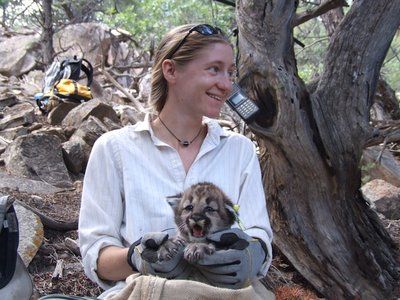The ever-intrepid watershed walkers had trekked their way down the side of a slope at Loch Lomond to the water’s edge in the middle of the hottest day of July 2010. Graduate students from Chris Wilmer’s Puma Project Lab at UCSC, who collar the cats, held up their antennae and began receiving radio signals immediately.
Each mountain lion has a different frequency, and Yiwei Wang and Veronica Yovovich identified this one has a female who was about two miles away from us and moving closer. Aren’t they supposed to sleep under shady trees during the day? The mountain lion researchers began dispelling our myths about the big cats that live among us.
Recently, a resident contacted the lab to report a freshly killed deer by a cougar with her two cubs. The team swung in to action, setting up cameras and two traps to catch and collar the cougar. Yovovich spent two nights alone in her van being awakened every half hour by an alert to check a signal that changes if a puma is around.
Like the first night, the second night was uneventful, so at 7 in the morning, Yovovich opened up the doors of the cages and left. If cats do not appear after a couple of nights, researchers presume they have moved on to other hunting grounds.
However, at 7:30 a.m., the cat family appeared, missing her by half an hour.
“She was being a good mom and keeping her kids away from people,” Yovovich said.
The UCSC Puma Project, the Felidae Conservation Fund and the Bay Area Puma Project initiated the first mountain lion study in the Santa Cruz Mountains in 2008 to increase their knowledge of the big cats and, among other goals, to:
– Find out if the population is increasing or decreasing.
– Learn how human disturbances have affected their survival.
– Use data to set up wildlife corridors across busy thoroughfares like Highway 17.
Yovovich explained that in Banff, Canada, a wildlife corridor has allowed elk and other animals to safely cross busy highways. (Visit www.wildlifeaccidents.ca/highway_managers.htm to see how it works.)
The researchers have lost two collared males due to depredation permits that allow owners who have lost pets and animals, such as goats, to kill mountain lions. When you live in prime cougar country, remember to provide safe shelter for animals in your care. In 2009, California gave out 93 permits, and 42 lions were killed.
Yovovich was allowed to participate in the necropsy of the lions by the Department of Fish and Game, learning more about them as she cut them open and participated in muscular sample-taking of the heart and tongue.
About 75 mountain lions live in San Mateo, Santa Clara and Santa Cruz counties. A male’s territory can range from 50 to 100 miles and a female’s from 12 to 50 miles. With the passage of Proposition 117 in 1990, mountain lions became a “specially protected species,” making mountain lion hunting illegal in California.
In June, Jodi McGraw, who led our Olympia Watershed walk earlier this summer, shot some great video of a mountain lion in Corralitos. (View it at www.youtube.com/watch?v=nRk4I_junkU- .)
If you would like a chance to track a mountain lion or just learn more about them, join us on another watershed walk at Loch Lomond with Wang and Yovovich on Aug. 20. Our walks are sponsored by an environmental education grant from the San Lorenzo Valley Water District.
For more information, email me at ca****@*********on.com.
To follow the progress of the Puma Project, contact http://felidaefund.org and http://people.ucsc.edu/~cwilmers/.
Carol Carson is a writer, naturalist and educator.












